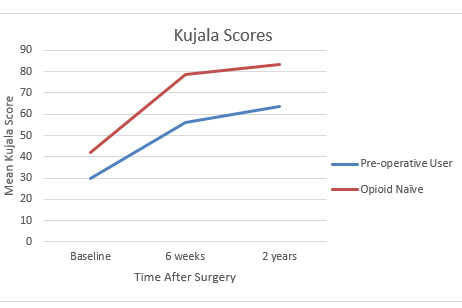BLOG: Preoperative opioids associated with postoperative use, inferior outcomes after patellofemoral stabilization surgery
The excessive prescribing and consumption of opioid pain medication has become a national focus. The United States is responsible for more than 80% of the world’s opioid use, and opioid-related deaths have increased more than 150% during the past 5 years. Orthopedic surgery has been highlighted as one of the most culpable surgical subspecialties, with many patients left with excess opioid pain medication following surgery. Previous studies have identified preoperative opioid use as an independent risk factor for postoperative opioid consumption in patients undergoing rotator cuff repair and ACL reconstruction. The purpose of the current study was to investigate the association between opioid consumption and postoperative patient-reported outcomes while identifying risk factors for postoperative opioid use in patients undergoing patellofemoral stabilization surgery.
A retrospective review of a prospectively collected patellofemoral patient cohort from a single, large academic medical center was performed. All patients in the cohort underwent patellofemoral stabilization surgery, consisting of Fulkerson osteotomy (anteromedialization of the tibial tubercle), medial patellofemoral ligament (MPFL) reconstruction or MPFL repair. The Kujala score and KOOS activities of daily living (ADL), pain, symptom, quality of life (QoL) and sport questionnaires were administered prior to surgery, 6 months following surgery and 2 years following surgery. Patient charts were reviewed to determine preoperative opioid use and postoperative opioid consumption at 2 and 6 weeks postoperatively. Preoperative opioid use was defined as opioid consumption within 3 months of surgery. Statistical analyses were performed using Fisher’s exact, Student’s t-test, and Wilcoxon rank sum test with statistical significance defined as P < .05.

A total of 61 patients (23 were men; 37.7%) were included in the study, with 12 preoperative opioid users (19.7%) and 49 opioid-naïve patients (80.3%) identified. There was no difference in gender (P = .934) or BMI (P = .061) between the two groups. The most common procedure was MPFL reconstruction (n=22; 36.1%), followed by Fulkerson osteotomy (n=16; 26.2%) and combined MPFL reconstruction and Fulkerson osteotomy (n=10; 16.4%). Postoperatively, 37 patients (60.7%) were using prescribed opioids at 2 weeks, while only 20 patients (32.8%) were still using opioid medications at 6 weeks. Preoperative opioid use was found to be an independent risk factor for continued use at both 2 weeks (P = .002) and 6 weeks (P < .001) postoperatively, as only one preoperative opioid user (8.3%) had discontinued use at 6 weeks compared to 40 in the opioid-naïve group (81.6%). The preoperative opioid user group was found to have significantly worse Kujala (P = .007), KOOS ADL (P = .006), KOOS pain (P = .034) and KOOS sport (P = .018) scores at 6 months postoperatively and worse Kujala (P = .002), KOOS ADL (P < .001), KOOS pain (P = .001), KOOS symptom (P =0.029), KOOS QoL (P = .001) and KOOS sport (P < .001) scores 2 years following surgery (Figure). Additionally, opioid use at 6 weeks postoperatively, irrespective of preoperative use, was associated with worse Kujala, KOOS ADL, KOOS pain, KOOS QoL and KOOS sport ( all P < .001, respectively) and KOOS symptom (P = .002; P = .004, respectively) results at both the 6-month and 2-year time points.
In patients undergoing patellofemoral stabilization surgery, preoperative opioid use was associated with higher rates of postoperative opioid pain medication use. Additionally, preoperative opioid use was associated with worse Kujala and KOOS scores at both 6 months and 2 years postoperatively.
These results may be used to counsel patients regarding expectations following surgery for those on opioid medication and to highlight the potential benefits of opioid cessation prior to surgery. Additionally, these findings provide further motivation for orthopedic surgeons to reduce excessive utilization of prescription opioids as postoperative outcomes following patellofemoral stabilization are significantly impacted. Further studies evaluating the utility of opioid cessation in this cohort are warranted.
References:
Anthony CA, et al. Am J Sports Med. 2017;doi:10.1177/0363546517719226.
Manchikanti L, et al. Pain Physician. 2008;11(2 Suppl):S63-88.
Volkow ND, et al. JAMA. 2011;doi:10.1001/jama.2011.401.
Westermann RW, et al. Arthroscopy. 2017;doi:10.1016/j.arthro.2017.03.016.
Disclosure: Bollier reports no relevant financial disclosures.
